

The French-style flutes are relatively thin walled (and so, are light) and have small holes. The embouchure size can vary a bit. They are the sweetest sounding 19th century flutes, some would say, and the high notes speak with little effort. The are perhaps the easiest 19th century flutes to play, especially for those who come from the one-key flute. They are not quiet, but the small holes keep them from having really large tones. I have heard them criticized for lacking "guts", but this is not entirely fair. They can compete with modern trumpets when played in the fourth octave in Cuban charanga.
Notice the "cross" G# key, with the G# hole on the player's side. The long c'' key must have a crook or bend in order jump the shaft of the G# key. The leverage is often good with this design, which can be seen on every flute shown on this page.
For some idea of the sound and playing qualities of the simple system French flute, you can read two English commentaries on the playing of Louis Drouet.
Because of the small holes, the forked F fingering (1234-6) worked pretty well, especially in the second octave, and the long F key (and its awkward technique) could be done without. The photo below is of Jules Arthur Hermant, winner of the 1849 competition of the Paris Conservatoire. As a student of Tulou, who vehemently opposed the Boehm flute, Hermant is, of course, using a simple system flute; but notice that he won the competition on a five-key flute—if one can judge from the engraving—and not an instrument with six, eight, or more keys.

Even at mid-century, French composers avoided use of notes below d'. An exception is E. Walckiers (a Belgian), who uses c' and even an occasional b.
In the second half of the 19th century, eight-key flutes are more common. Shown below are late 19th century flutes by Martin Freres (Paris) and Thibouville-Cabart (Paris) with eight and ten keys.

Price lists from the firm of Louis Lot, under various proprieters, continued to list Flûtes Ordinaires (simple system flutes) into the 20th century. See Tula Gianini's Great Flute Makers of France, Tony Bingham, London, 1993. They offered five and eight-key models only. Of course, simple system flutes were not their main interest by any means. Here is a fragment of a 1905 price list.
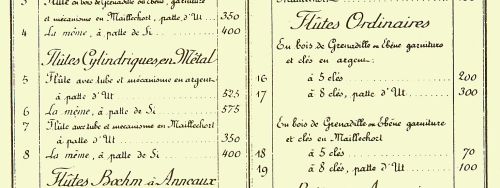
I have never understood why an 8-key flute with silver keys cost three times as much (300 francs, more than half of what a silver flute cost) as an 8-key flute with keys of maillechort (100 francs). Perhaps more care was taken in the manufacture in other respects.
There were more elaborate and interesting French flutes, some with many more keys. The Tulou flûte perfectioneé was mentioned in passing in the section on 19C simple system flutes, I.
The French started, early in the 19th century, mounting keys on posts and axles rather than in blocks or knobs integral to the material of the body. (Later, posts would be screwed directly into the wood.) At first, the posts were soldered to small silver plates, which were attached to the body of the flute with small screws. This idea was patented in 1806 by Claude Laurent, who used the method to mount keys on his crystal glass flutes. Laurent and his successor Breton made glass flutes from 1806 until 1857. Below is a seven-key flute made by Laurent in 1834. (The flute orginally had eight keys, but the foot joint was broken, probably in the 19th century, and has been somewhat crudely repaired by having the footjoint shortened, to terminate at C#.)

The grooves in the glass are to keep the weight down, in addition to being ornamental. In the photo below, of the G# key on the upper center and environs, one can see the plates supporting the G# key and the long C key. On this flute, there is a single screw in the middle of each plate (under the axle) that goes entirely through the glass body.

Note the threaded tenon that screws into the socket of the lower center. Also note that the "undercutting" of hole 3 is completely visible through the glass, and one can see how much the tone hole enlarges as it meets the bore of the flute.
Some of the nicer early 19th century French flutes have elaborate plates and keys. Here is a seven-key flute by Tabard (Lyon, c.1825).
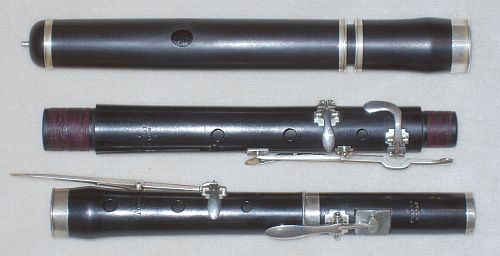
Actually, the head is not original, and the current long C and long F keys are replacements for the lost originals. The work was done by Michael Hubbert, with assistance on the voicing by Rod Cameron.
Here are five views of the D# key. From the top, and from the side, but closed. Then three views of it open. Notice that the key flap pivots on an axle. This is to help it seat well, even if the leather on the flap changes with weather or replacement.
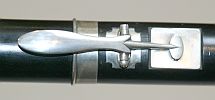
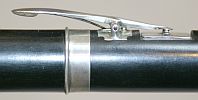
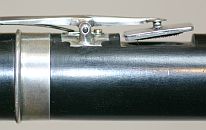
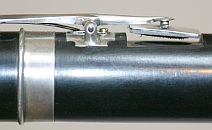
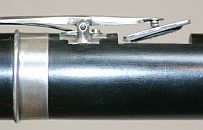
Before mid-century, many good French flutes had metal lined sockets, and tenons were also partially metal covered. Cork was used on the tenons. If there is no tuning head, the head joint socket often has a secondary, tenon-like tube of metal that fit under the tenon of the upper center, so that it could be extracted a small amount for tuning without creating a wide gap in the bore. This would become standard on wooden Boehm flutes. Shown below are the upper tenon on the upper center, the head joint socket, and the lower center socket on the flute by Noë.
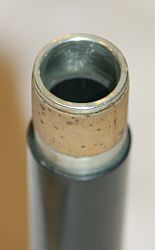
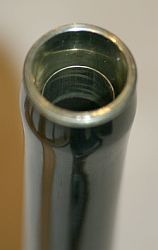
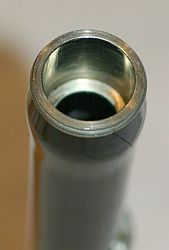
When tuning heads were present, the head joint was partially lined with metal. But only partially, because the metal lining was thought to harm the tone. The head joint below belongs to the instrument by Sax. The barrel joint has been removed completely. The arrow shows the approximate place where the metal tube extending from the head proper ends. There is no metal in the embouchure or cork area.

Not every French simple system flute has the smallest holes. Here is a 10-key flute by Buffet Crampon (Paris, c.1900) with medium size holes. It is a Eb flute at a very high pitch, and presumably a band instrument. This flute does have a completely metal lined head joint.

The adoption of the silver Boehm flute by the Paris Conservatoire in 1860 signaled the end of the serious use of the simple system in France. Of course, it remained in somewhat less serious use well into the 20th century, but no French composers wrote with it in mind. Still, there are many flutists today who insist that silver flutes made by Godfroy and Lot circa 1860 have much more of the sweet sound of the old flute in them than modern silver flutes do. I don't know.